一般过去时变否定句和一般疑问句
一般过去时的疑问句和否定句

一般过去时的疑问句和否定句一般过去时表示过去某个时间里发生的动作或状态,它的疑问句和否定句形式如下:
1.疑问句:
(1)Was/Were+主语+其他?
(2)Did+主语+动词原形+其他?
例如:
(1)Was he at home yesterday?(他昨天在家吗?)
(2)Did you go to the park last weekend?(你上周末去公园了吗?)
2.否定句:
(1)主语+was/were+not+其他.
(2)主语+did+not+动词原形+其他.
例如:
1.He was not at home yesterday.(他昨天不在家。
)
2.I did not go to the park last weekend.(我上周末没去公园。
)
需要注意的是,在使用一般过去时时,要根据主语的人
称和数来确定be动词的形式,第一人称和第三人称单数用was,其余情况用were;而实义动词则用过去式形式,如went、ate、played等。
一般过去时特殊变化总结

一般过去时特殊变化总结1.一般过去时表示过去某个时间发生的动作或存在的状态,常和表示过去的时间状语连用。
一般过去时也表示过去经常或反复发生的动作。
2.Be动词在一般过去时中的变化:⑴am 和is在一般过去时中变为was。
(was not=wasn’t)⑵are在一般过去时中变为were。
(werenot=weren’t)⑶带有was或were的句子,其否定、疑问的变化和is, am, are一样,即否定句在was 或were后加not,一般疑问句把was或were调到句首。
3.句中没有be动词的一般过去时的句子否定句:didn’t +动词原形,如:Jim didn’t go home yesterday.一般疑问句:在句首加did,句子中的动词过去式变回原形。
如:Did Jim go home yesterday?特殊疑问句:⑴疑问词+did+主语+动词原形? 如: What did Jim do yesterday?⑵疑问词当主语时:疑问词+动词过去式? 如:Who went to home yesterday?4、动词过去式变化规则:1)一般在动词末尾加-ed,如:pull-pulled, cook-cooked2)结尾是e加d如: pnone- pnoned 打电话,like -liked喜欢,live-lived居住度过,tie-tied扎上,系上 love-loved爱,喜爱,wake-waked醒来 close-closed结束关闭exercise-exerised运用练习,dance-danced跳舞,scare-scared惊恐、害怕,taste-tasted 品尝体验bounce-bounced弹起跳起practise-practised实践开业,raise-raised升起举起donate-donated捐赠; 捐献3)末尾只有一个元音字母和一个辅音字母的重读闭音节,应双写末尾的辅音字母,再加-ed,如:stop--stopped 停止hop-hopped跳跃skip-skipped跳过Plan--planned 安排、设计fit--fitted 适合;安装drop--dropped放弃;停止refer-referred谈及;咨询regret-regretted后悔;惋惜 ban-banned禁止剥夺权利4)以“辅音字母+y”结尾的,变y为i,再加-ed,如:try-tried尝试;努力 cry.-cried 哭;喊 carry-carried 拿搬worry-worried 担心;烦恼study-studied学习,研究hurry-hurried赶紧copy-copied 复制;抄写 embody-embodied 包含 justify-justified证明...是正当的empty-emptied倒空 marry-married结婚5)不规则动词过去式①与原型相同cut-cut 切 hurt-hurt伤害、使疼痛 put-put放 read- read读 must-must必须hit-hit 击打 shut-shut关闭 let-let让 set-set设置 cost-cost代价;花费Beat-beat 打、敲、打败 spread-spread传播、打开②采用不同的词根变化③变词尾的d为tS end-s ent 送邮寄 sp end-sp ent花(钱);花费(时间) l end-l ent借借给;给予b end-b ent弯曲;屈身 buil d-buil t 建筑建造;增加④末尾加一个辅音字母hear- heard听 learn-learnt学习 burn-burnt燃烧烧坏晒伤mean-meant打算导致意味着 dream-dreamt 梦见梦想考虑⑤改变一个辅音字母pass-past通过经过 make-made做⑥变ay为aids ay -s aid讲;说明 p ay -p aid付(款),支付l ay -l aid 放置下(蛋)产(卵)(注意:play-played)⑦去掉一个元音字母meet-met见到 feed-fed 喂 speed-sped 加速、移动choose-chose选择挑选 shoot-shot射击发射lead-led 带领带路 hide-hid隐藏遮住⑧改变一个元音字母改变i为o的,如:Write- wrote写 drive-drove驾驶 ride-rode骑win-won 获胜赢rise-rose升起站立增加 shine-shone 闪耀擦亮改变i为a的,如:Swim-swam游泳 begin-began开始;始于 sing-sang唱歌ring -rang响 sit-sat坐 drink-drank喝、改变 give-gave给予赠予改变i为u的,如:dig-dug 掘凿挖 swing-swung摆动摇摆stick-stuck粘贴刺插钉住改变o为a的,如:Come-came来 be come-be came变成改变o为e的,如:know-knew知道 grow-grew 种植;生长;培养hold-held 抓住持有 blow-blew 刮吹炸毁 throw-threw 掷扔板动改变e为o的,如:get-got得到for get-for got忘记改变a为e的,如:draw-drew画 fall--fell落下摔倒倒塌改变a为u的,如:hang-hung 悬挂垂下改变a为o的,如:wake-woke 醒来改变u为a的,如: Run-ran跑⑨改一个元音为辅音字母see-saw看见 lose-lost丢失⑩字母组合改变T ake-t ook拿到、带;拍摄 mistake-mistook误解口误 sh ake-sh ook摇动抖动stand-stood 站立忍受 understand-understood理解解释领会wear-wore穿戴 bear-bore 承受承担具有speak- spoke讲话 break-broke 破裂碎损坏Leave-l eft离开 sleep - slept睡觉 keep-kept 保持重复留下 sweep-swept 打扫扫feel-f elt感觉Smell-slelt(smelled)气味闻到 spell-spelt 拼写招致⑾系动词助动词情态动词等am,is-was是 are--were是 do-did 做 have(has)-had有can -c ould能 may-might 可能 will-w ould意愿 Shall-sh ould将将要应该⑿其他特殊变化的动词go- went去 eat-ate 吃 Steal-stole 偷窃抢(戏)断(球)lie-lay 躺平卧位于 Find-found找寻发现 fly -flew 飞light-lit 照亮燃烧点燃句中be动词和动词一般情况下只能有一种而且也必须有一种。
一般过去时

5. When he was four /
6. 相对标志词 : this morning
双 写 加
动词过去式的变化规则
III. 直 接 加 加 “ 加 “ 的 去 “ 结 尾 e” 以 辅 音 字 母 I. e” , ing”. ing
II. ing
动 1.以辅音字母加 “e” 结尾的动词直接加 以辅音字母加 词 “d”. 的
4. 直接加“ed”. play--played 直接加“ work--worked
规律性不强,需要强行记忆。
2.不规则的动词。 2.不规则的动词。 不规则的动词
• 1).保持原形。如let—let; put--put 1).保持原形 保持原形。 let— put---put 变化元音字母。 come— • 2).变化元音字母。如come—came; 2).变化元音字母 drive--drove drive--drove -• 3).变化辅音字母。如lend—lent; 3).变化辅音字母 变化辅音字母。 lend— spend--spent spend--spent -• 4).元音和辅音字母都有变化。如 4).元音和辅音字母都有变化 元音和辅音字母都有变化。 catch— think---thought catch—caught; think--thought
一般过去时的用法和结构
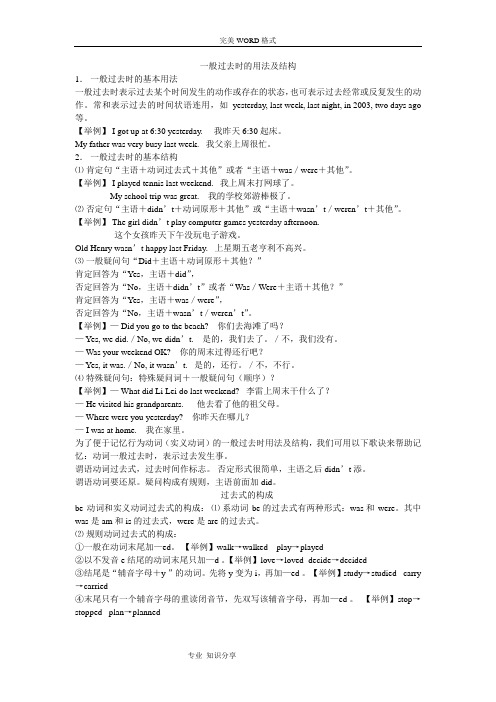
一般过去时的用法及结构1.一般过去时的基本用法一般过去时表示过去某个时间发生的动作或存在的状态,也可表示过去经常或反复发生的动作。
常和表示过去的时间状语连用,如yesterday, last week, last night, in 2003, two days ago 等。
【举例】 I got up at 6:30 yesterday. 我昨天6:30起床。
My father was very busy last week. 我父亲上周很忙。
2.一般过去时的基本结构⑴肯定句“主语+动词过去式+其他”或者“主语+was/were+其他”。
【举例】 I played tennis last weekend. 我上周末打网球了。
My school trip was great. 我的学校郊游棒极了。
⑵否定句“主语+didn’t+动词原形+其他”或“主语+wasn’t/weren’t+其他”。
【举例】 The girl didn’t play computer games yesterday afternoon.这个女孩昨天下午没玩电子游戏。
Old Henry wasn’t happy last Friday. 上星期五老亨利不高兴。
⑶一般疑问句“Did+主语+动词原形+其他?”肯定回答为“Yes,主语+did”,否定回答为“No,主语+didn’t”或者“Was/Were+主语+其他?”肯定回答为“Yes,主语+was/were”,否定回答为“No,主语+wasn’t/weren’t”。
【举例】— Did you go to the beach? 你们去海滩了吗?— Yes, we did./No, we didn’t. 是的,我们去了。
/不,我们没有。
— Was your weekend OK? 你的周末过得还行吧?— Yes, it was./No, it wasn’t. 是的,还行。
/不,不行。
英语四个基本时态的 肯定句变否定句

_M_r_s_.__L_i_a_n_d__K_i_t_t_y__a_r_e__n_o__t_i_n__a_b__ig__s_h_o_p__. ________ .
8. He is crying(哭) under the tree.
____H__e_i_s_n__o_t__c_r_y_i_n_g_(__哭__)___u_n_d_e_r__t_h_e__t_r_e_e__. _____ .
9. His birthday is on the twentieth of November.
The old man doesn’t do morning exercises(早操) every morning.
23. We are from China.
_________W___e__a_r__e_n__’t__f__r_o_m___C__h_i_n_a__.________ .
24. He goes to the library(图书馆) on Sundays.
_____H_e__d_o_e_s_n_’_t__g_o_t_o__th__e_l_ib_r_a_r_y__o_n_S_u_n_d_a_y_s_.____ .
25. They have a class meeting every week.
_T_h__e_y_d__o_n_’t__h_a_v_e__a__c_l_a_s_s_m__e_e_t_i_n_g__e_v_e_r_y__w__e_e_k_. .
一般过去时的否定句和疑问句

一般过去时的否定句和疑问句一般过去时的否定句(Negative Sentences in Simple Past Tense)一般过去时的否定句用于描述过去发生的事情中的否定情况。
构成一般过去时的否定句需要在动词前加上助动词 "did not" 或"didn't",并将动词本身保持原形。
以下是构成一般过去时的否定句的示例:1. 主语 + did not/didn't + 动词原形 + 其他成分- 例如:She did not/didn't go to the party last night.2. 主语 + did not/didn't + 动词原形 + 否定词 + 其他成分- 例如:I didn't see anyone in the park yesterday.需要注意的是,当动词本身为be动词时,不需要再使用助动词 "did"。
直接在be动词前加上 "not" 即可构成否定句。
例如:一般过去时的疑问句(Interrogative Sentences in Simple Past Tense)一般过去时的疑问句用于询问过去发生的事情。
构成一般过去时的疑问句需要将助动词 "did" 放在主语之前,并将动词本身保持原形。
以下是构成一般过去时的疑问句的示例:1. Did + 主语 + 动词原形 + 其他成分?- 例如:Did you study for the test yesterday?2. Did + 主语 + 动词原形 + 否定词 + 其他成分?- 例如:Did she not/didn't watch the movie last night?当动词本身为be动词时,同样需要将助动词 "did" 放在主语之前,形成疑问句。
一般过去时知识点
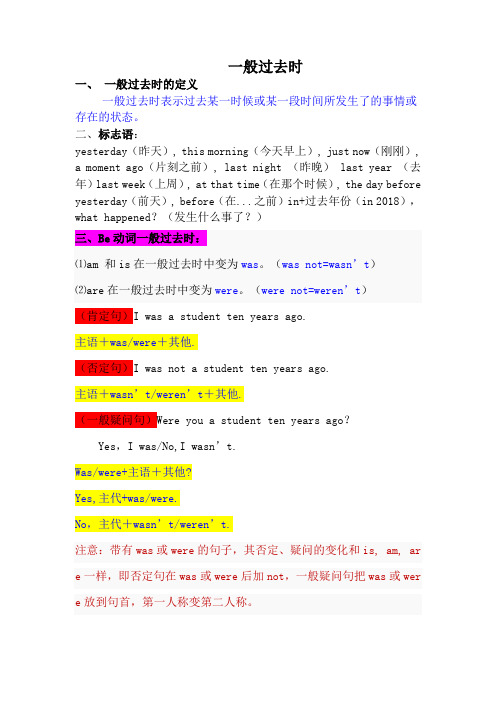
一般过去时一、一般过去时的定义一般过去时表示过去某一时候或某一段时间所发生了的事情或存在的状态。
二、标志语:yesterday(昨天), this morning(今天早上), just now(刚刚), a moment ago(片刻之前), last night (昨晚) last year (去年)last week(上周), at that time(在那个时候), the day before yesterday(前天), before(在...之前)in+过去年份(in 2018),what happened?(发生什么事了?)三、Be动词一般过去时:⑴am 和is在一般过去时中变为was。
(was not=wasn’t)⑵are在一般过去时中变为were。
(were not=weren’t)(肯定句)I was a student ten years ago.主语+was/were+其他.(否定句)I was not a student ten years ago.主语+wasn’t/weren’t+其他.(一般疑问句)Were you a student ten years ago?Yes,I was/No,I wasn’t.Was/were+主语+其他?Yes,主代+was/were.No,主代+wasn’t/weren’t.注意:带有was或were的句子,其否定、疑问的变化和is, am, ar e一样,即否定句在was或were后加not,一般疑问句把was或wer e放到句首,第一人称变第二人称。
(特殊疑问句)1.对I提问:Who was a student ten years ago?(Who作为主语时,谓语动词用三单)四、实义动词一般过去时:(肯定句)I walked to school yesterday.主语+动词过去式+其他.(否定句)I didn’t walk to school yesterday.主语+didn’t + 动词原形+其他.否定句变化规则:1、找be动词2、若无be动词,找情态动词(could)3、若无情态动词,请助动词(did)来帮助4、did放于主语的后面,动词的前面,加上not,did not= didn't5、动词变原形6、some->any and->or too->either(一般疑问句)Did you walk to school yesterday?Yes,I did. No,I didn’t.Did +主语+动词原形+其他?Yes,主代+did.No,主代+didn’t.一般疑问句变化规则:1、找be动词2、若无be动词,找情态动词(could)3、若无情态动词,请助动词(did)来帮助4、did放于开头,首字母大写5、第一人称变第二人称6、动词变原形7、some->any and->or too不变either(特殊疑问句)I went to school on foot yesterday.1.对I 提问:Who went to school on foot yesterday?2.对went to school 提问:What did you do on foot yesterday?3.对school 提问:Where did you go on foot yesterday?4.对on foot 提问:How did you go to school yesterday?5.对yesterday提问:When did you go to school on foot?动词变化规则:1、直接在动词后面加ed。
一般过去时的知识点归纳
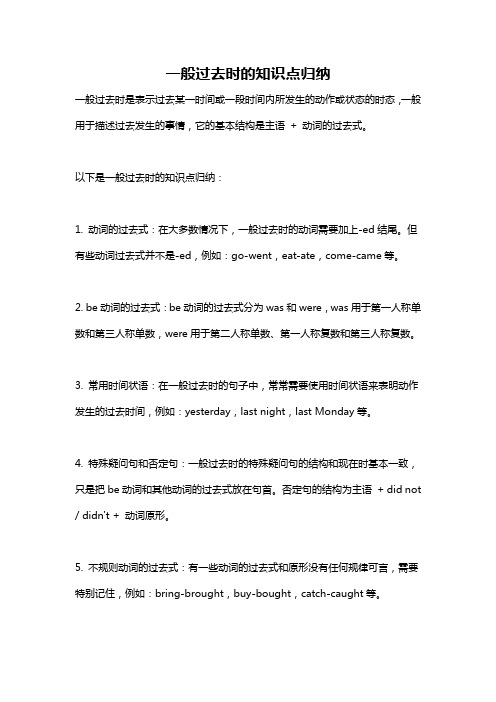
一般过去时的知识点归纳一般过去时是表示过去某一时间或一段时间内所发生的动作或状态的时态,一般用于描述过去发生的事情,它的基本结构是主语+ 动词的过去式。
以下是一般过去时的知识点归纳:1. 动词的过去式:在大多数情况下,一般过去时的动词需要加上-ed结尾。
但有些动词过去式并不是-ed,例如:go-went,eat-ate,come-came等。
2. be动词的过去式:be动词的过去式分为was和were,was用于第一人称单数和第三人称单数,were用于第二人称单数、第一人称复数和第三人称复数。
3. 常用时间状语:在一般过去时的句子中,常常需要使用时间状语来表明动作发生的过去时间,例如:yesterday,last night,last Monday等。
4. 特殊疑问句和否定句:一般过去时的特殊疑问句的结构和现在时基本一致,只是把be动词和其他动词的过去式放在句首。
否定句的结构为主语+ did not / didn't + 动词原形。
5. 不规则动词的过去式:有一些动词的过去式和原形没有任何规律可言,需要特别记住,例如:bring-brought,buy-bought,catch-caught等。
6. 短语动词的过去式:短语动词的过去式一般是由动词原形和前缀或后缀组成,例如:give up-gave up,look for-looked for,break down-broke down等。
7. 时态转换:如果句子中已经使用了过去式的时间状语,那么主语动词不必再使用过去式,而可以使用现在完成式或过去完成式等。
8. 多重动作的描述:当一句话中有多个动作需要被描述时,需要注意动作发生的先后顺序和时态的运用,通常需要使用时间状语、连接词或使用逗号分开多个动作。
一般过去时的肯定句,否定句,一般疑问句,特殊疑问句
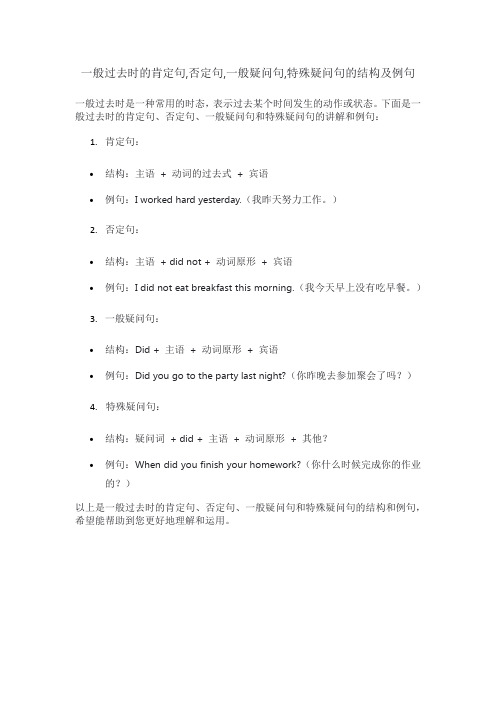
一般过去时的肯定句,否定句,一般疑问句,特殊疑问句的结构及例句
一般过去时是一种常用的时态,表示过去某个时间发生的动作或状态。
下面是一般过去时的肯定句、否定句、一般疑问句和特殊疑问句的讲解和例句:
1.肯定句:
•结构:主语+ 动词的过去式+ 宾语
•例句:I worked hard yesterday.(我昨天努力工作。
)
2.否定句:
•结构:主语+ did not + 动词原形+ 宾语
•例句:I did not eat breakfast this morning.(我今天早上没有吃早餐。
)
3.一般疑问句:
•结构:Did + 主语+ 动词原形+ 宾语
•例句:Did you go to the party last night?(你昨晚去参加聚会了吗?)
4.特殊疑问句:
•结构:疑问词+ did + 主语+ 动词原形+ 其他?
•例句:When did you finish your homework?(你什么时候完成你的作业的?)
以上是一般过去时的肯定句、否定句、一般疑问句和特殊疑问句的结构和例句,希望能帮助到您更好地理解和运用。
一般过去时

表示过去发生的动作或状态。
一.表示状态使用:主语+be(过去式)+表语+时间状语具体见下表:主语+be(过去式)+表语+时间状语主语be 表语时间状语人称代词主语i / she / he / it was1.形容词2.名词3. 人称代词宾格(me /you / her /him / it /us /them)1.表示过去的时间副词2.副词ago(…前)相关(1.a/an/one+表时间名词单数+ago;2.数词+表时间名词复数+ago)3.介词in(在)+表过去年份数词st(上一)+表时间名词单数5.that/this(那/今)+表时间名词单数we / you / they were指示代词that / this was these / those were名词可数名词单数和was可数名词复数were不可数名词was 单个人(地)名was并列多个个人(地)名were名词使用规则1.可数名词单数必须加限定词或冠词。
2.可数名词复数和不可数名词不加限定词或冠词一般是泛指某一类。
变一般否定句:主语+be(过去式)+not +表语+时间状语变一般疑问句:be(过去式)+主语+表语+时间状语?(此时注意人称代词如i的改变和be动词的改变。
)肯定回答:yes,主语+be(过去式)否定回答:no,主语+be(过去式)+not二.表示动作使用:主语+谓语+宾语具体见下表:主语+(及物动词过去式)谓语+宾语+时间状语主语+(不及物动词过去式)谓语+时间状语主语谓语宾语时间状语人称代词主格i / she / he / it / we/ you / they1.及物动词过去式1.名词或人称代词宾格1.表示过去的时间副2.副词ago相关(1.a/an/one+表时间名词单数+ago2.数词+表时间名词复数+ago)3.介词in+表过去年份数词st+表时间名词单数5.that/this+表时间名词单数名词包括:单个或并列人(地)名、可数名词单数或复数、不可数名词。
一般过去式的否定句以及疑问句
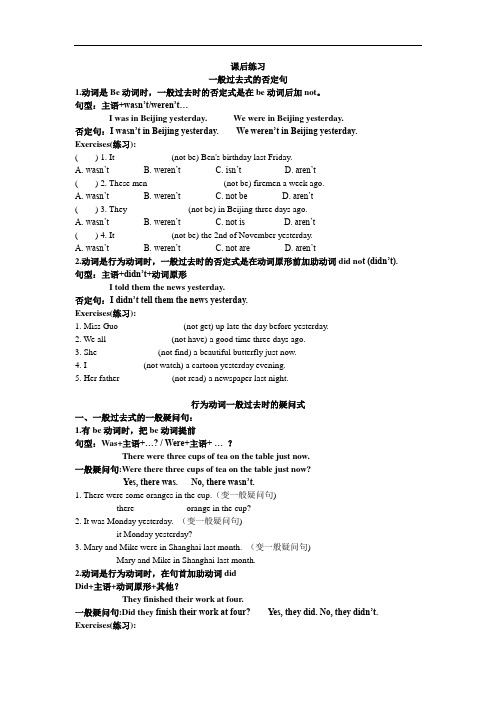
课后练习一般过去式的否定句1.动词是Be动词时,一般过去时的否定式是在be动词后加not。
句型:主语+wasn’t/weren’t…I was in Beijing yesterday. We were in Beijing yesterday.否定句:I wasn’t in Beijing yesterday. We weren’t in Beijing yesterday. Exercises(练习):( ) 1. It ____________ (not be) Ben's birthday last Friday.A. wasn’tB. weren’tC. isn’tD. aren’t( ) 2. These men_________________ (not be) firemen a week ago.A. wasn’tB. weren’tC. not beD. aren’t( ) 3. They _____________ (not be) in Beijing three days ago.A. wasn’tB. weren’tC. not isD. aren’t( ) 4. It ____________ (not be) the 2nd of November yesterday.A. wasn’tB. weren’tC. not areD. aren’t2.动词是行为动词时,一般过去时的否定式是在动词原形前加助动词did no t (didn’t).句型:主语+didn’t+动词原形I told them the news yesterday.否定句:I didn’t tell them the news yesterday.Exercises(练习):1. Miss Guo ______________ (not get) up late the day before yesterday.2. We all ______________ (not have) a good time three days ago.3. She _____________ (not find) a beautiful butterfly just now.4. I ____________ (not watch) a cartoon yesterday evening.5. Her father ___________ (not read) a newspaper last night.行为动词一般过去时的疑问式一、一般过去式的一般疑问句:1.有be动词时,把be动词提前句型:Was+主语+…? / Were+主语+ …?There were three cups of tea on the table just now.一般疑问句:Were there three cups of tea on the table just now?Yes, there was. No, there wasn’t.1. There were some oranges in the cup.(变一般疑问句)_________ there ___________ orange in the cup?2. It was Monday yesterday. (变一般疑问句)_________ it Monday yesterday?3. Mary and Mike were in Shanghai last month. (变一般疑问句)_________ Mary and Mike in Shanghai last month.2.动词是行为动词时,在句首加助动词didDid+主语+动词原形+其他?They finished their work at four.一般疑问句:Did they finish their work at four? Yes, they did. No, they didn’t. Exercises(练习):1._______ he ______ (go) to that morning? Yes, he _____.2._________your brother ___________(find) some meat in the fridge(冰箱). No, he _________.3.________ Mary _______ (read) an interesting book about history? Yes, she __________.4.________ the students of Class Six _________(have) an English lesion the day before yesterday? No, they didn’t.二、一般过去时的特殊疑问式1.动词是行为动词时: 疑问词+did+主语+动词原形……?They finished their work at four.A B对划线部分提问: A:What did they do at four?B:When did they finish their work?Exercises(练习):1.They went to park by car yesterday.________ _________ they __________ to park yesterday?2.They did their homework yesterday evening.________ did they_________ yesterday evening?3.Her sisters flew kites in the park last Friday.________ did her sisters _________kites last Friday?4. I liked the red shirt in the past.________ shirt did you ________ in the past.2.有be动词时: 疑问词+ was/were+主语+其他?Jack was in the classroom just now.A B对划线部分提问: A: Who was in the classroom just now?B: Where was Jack just now?1.Mary and Peter were in Beijing five days ago.________ ________ Mary and Peter five days ago?2.There were four teachers in the office._______ ________ teacher _______ there in the office?3.He was a policeman last year._______ ________ he in the past?4.Mike was a teacher in the past.________ _________ a teacher in the past?。
初中英语知识点:一般过去时
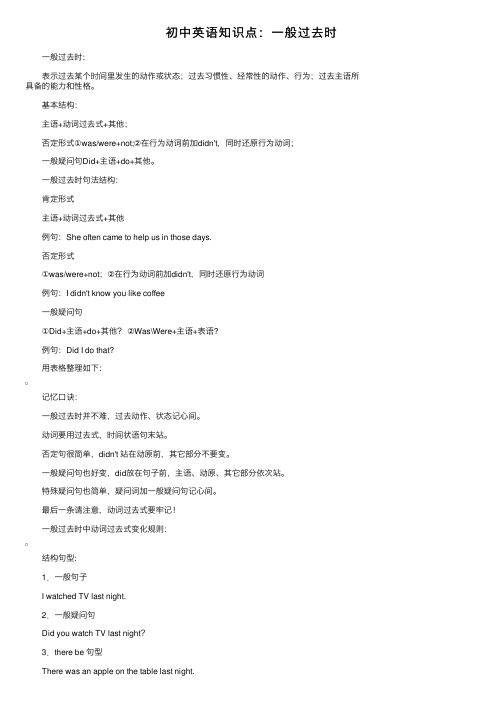
初中英语知识点:⼀般过去时 ⼀般过去时: 表⽰过去某个时间⾥发⽣的动作或状态;过去习惯性、经常性的动作、⾏为;过去主语所具备的能⼒和性格。
基本结构: 主语+动词过去式+其他; 否定形式①was/were+not;②在⾏为动词前加didn't,同时还原⾏为动词; ⼀般疑问句Did+主语+do+其他。
⼀般过去时句法结构: 肯定形式 主语+动词过去式+其他 例句:She often came to help us in those days. 否定形式 ①was/were+not;②在⾏为动词前加didn't,同时还原⾏为动词 例句:I didn't know you like coffee ⼀般疑问句 ①Did+主语+do+其他?②Was\Were+主语+表语? 例句:Did I do that? ⽤表格整理如下: 记忆⼝诀: ⼀般过去时并不难,过去动作、状态记⼼间。
动词要⽤过去式,时间状语句末站。
否定句很简单,didn't 站在动原前,其它部分不要变。
⼀般疑问句也好变,did放在句⼦前,主语、动原、其它部分依次站。
特殊疑问句也简单,疑问词加⼀般疑问句记⼼间。
最后⼀条请注意,动词过去式要牢记! ⼀般过去时中动词过去式变化规则: 结构句型: 1.⼀般句⼦ I watched TV last night. 2.⼀般疑问句 Did you watch TV last night? 3.there be 句型 There was an apple on the table last night. Was there an apple on the table last night ⼀般过去时注意事项: 1.注意主句与从句中时态的⼀致性 如果主句⽤了过去时,从句中⼀般也要⽤过去式,或者过去进⾏时、过去完成时等。
例如: He believed that he was right. 他相信⾃⼰是对的。
一般现在时、一般过去时、一般将来时

教学内容知识点一:一般现在时【知识梳理】(1)一般现在时的基本结构和变化1.一般现在时的结构①be动词:主语+be(am, is, are)+其它。
e.g. I am a boy.我是一个男孩。
②行为动词:主语+行为动词(+其它)。
一般现在时主要用动词的原形表示,如果主语是第三人称单数,则在动词原形后加"-s"或"-es"e.g. He gets up early in the morning.2.否定句和疑问句的变化①be动词的变化:A.否定句:主语+ be + not +其它。
He is not a worker.他不是工人。
B. 一般疑问句:Be +主语+其它。
---Are you a student? ---Yes. I am. / No, I'm not.C. 特殊疑问句:疑问词+一般疑问句。
Where is my bike?②行为动词的变化:A.否定句:主语+ don't( doesn't ) +动词原形(+其它)。
I don't like bread. / He doesn't like bread.B. 一般疑问句:Do ( Does ) +主语+动词原形+其它。
---Do you often play football? --- Yes, I do. / No, I don't.--- Does she go to work by bike? --- Yes, she does. / No, she doesn't.C. 特殊疑问句:疑问词+一般疑问句。
How does your father go to work?(注意回顾动词第三人称单数形式变化规则)一般情况下在词尾加s help→helps, clean→cleans, play→plays, wear→wears, give→gives; 以s, x, ch, sh结尾的动词在词尾加es dress→dresses, fix→fixes, watch→watches, finish→finishes;以“辅音字母加y”结尾的动词,把y变为i,再study→studies, carry→carries, fly→flies )(2)一般现在时的用法•1.表示经常性或习惯性的动作或行为。
一般过去时的概念
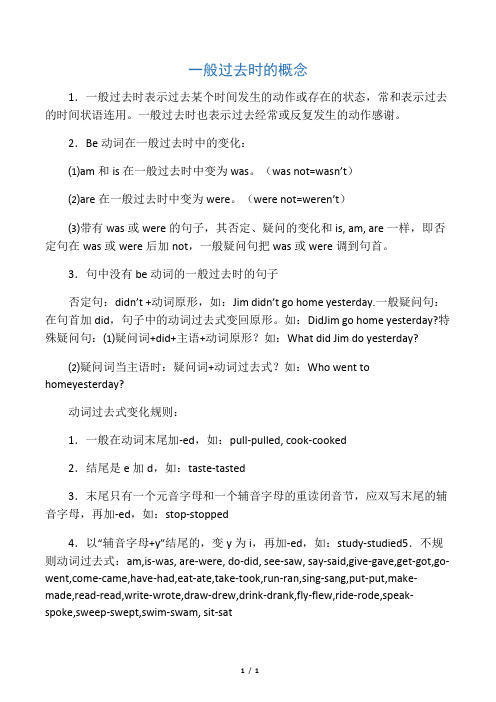
一般过去时的概念1.一般过去时表示过去某个时间发生的动作或存在的状态,常和表示过去的时间状语连用。
一般过去时也表示过去经常或反复发生的动作感谢。
2.Be动词在一般过去时中的变化:⑴am和is在一般过去时中变为was。
(was not=wasn’t)⑵are在一般过去时中变为were。
(were not=weren’t)⑶带有was或were的句子,其否定、疑问的变化和is, am, are一样,即否定句在was或were后加not,一般疑问句把was或were调到句首。
3.句中没有be动词的一般过去时的句子否定句:didn’t +动词原形,如:Jim didn’t go home yesterday.一般疑问句:在句首加did,句子中的动词过去式变回原形。
如:DidJim go home yesterday?特殊疑问句:⑴疑问词+did+主语+动词原形?如:What did Jim do yesterday?⑵疑问词当主语时:疑问词+动词过去式?如:Who went to homeyesterday?动词过去式变化规则:1.一般在动词末尾加-ed,如:pull-pulled, cook-cooked2.结尾是e加d,如:taste-tasted3.末尾只有一个元音字母和一个辅音字母的重读闭音节,应双写末尾的辅音字母,再加-ed,如:stop-stopped4.以“辅音字母+y”结尾的,变y为i,再加-ed,如:study-studied5.不规则动词过去式:am,is-was, are-were, do-did, see-saw, say-said,give-gave,get-got,go-went,come-came,have-had,eat-ate,take-took,run-ran,sing-sang,put-put,make-made,read-read,write-wrote,draw-drew,drink-drank,fly-flew,ride-rode,speak-spoke,sweep-swept,swim-swam, sit-sat1/ 1。
小学一般过去式句型转换
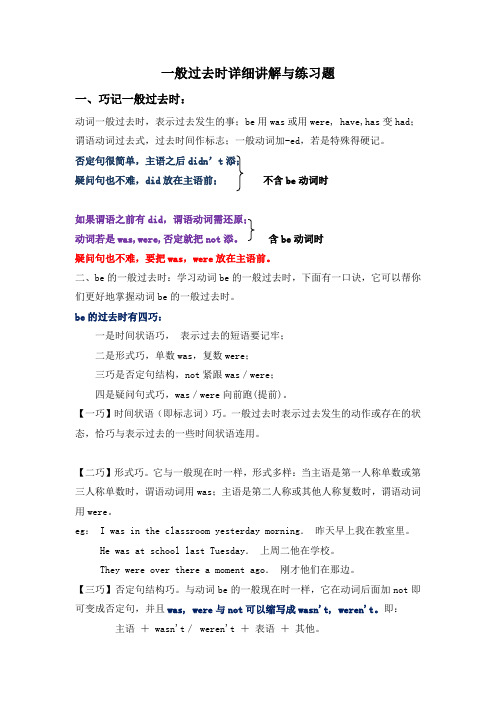
一般过去时详细讲解与练习题一、巧记一般过去时:动词一般过去时,表示过去发生的事;be用was或用were, have,has变had;谓语动词过去式,过去时间作标志;一般动词加-ed,若是特殊得硬记。
否定句很简单,主语之后didn’t添;疑问句也不难,did放在主语前;不含be动词时如果谓语之前有did,谓语动词需还原;动词若是was,were,否定就把not添。
含be动词时疑问句也不难,要把was,were放在主语前。
二、be的一般过去时:学习动词be的一般过去时,下面有一口诀,它可以帮你们更好地掌握动词be的一般过去时。
be的过去时有四巧:一是时间状语巧,表示过去的短语要记牢;二是形式巧,单数was,复数were;三巧是否定句结构,not紧跟was/were;四是疑问句式巧,was/were向前跑(提前)。
【一巧】时间状语(即标志词)巧。
一般过去时表示过去发生的动作或存在的状态,恰巧与表示过去的一些时间状语连用。
【二巧】形式巧。
它与一般现在时一样,形式多样:当主语是第一人称单数或第三人称单数时,谓语动词用was;主语是第二人称或其他人称复数时,谓语动词用were。
eg: I was in the classroom yesterday morning.昨天早上我在教室里。
He was at school last Tuesday.上周二他在学校。
They were over there a moment ago.刚才他们在那边。
【三巧】否定句结构巧。
与动词be的一般现在时一样,它在动词后面加not即可变成否定句,并且was, were与not可以缩写成wasn't, weren't。
即:主语+ wasn't/ weren't +表语+其他。
例如:I was not (=wasn't) here yesterday.昨天我不在这儿。
My parents were not (=weren't) at home last Sunday.上周日我父母不在家。
(知识点)理解一般过去时的肯定否定和疑问句

(知识点)理解一般过去时的肯定否定和疑问句理解一般过去时的肯定、否定和疑问句一、肯定句一般过去时表示过去发生的动作或状态,肯定句的结构为:“主语 + 动词过去式 + 其他”。
例如:- She studied English last night.- We went camping last summer.二、否定句在一般过去时的否定句中,使用助动词"did not"或其缩写形式"didn't"来构成。
句子结构为:“主语 + did not + 动词原形 + 其他”。
例如:- He did not watch TV yesterday.- They didn't play football last weekend.三、疑问句1. 一般疑问句构成一般过去时的疑问句需要将助动词"did"提到句子的主语之前,句子结构为:“Did + 主语 + 动词原形 + 其他?”例如:- Did she go to the party?- Did they eat dinner at home?2. 特殊疑问句特殊疑问句是以疑问词引导的疑问句,疑问词可以是who, what, where, when, why, how等。
在一般过去时的特殊疑问句中,同样需要将助动词"did"放在疑问词之前,句子结构为:“疑问词 + did + 主语 + 动词原形 + 其他?”例如:- What did you do yesterday?- Where did they go for vacation?说明:- 一般过去时的肯定句中,动词需要变为过去式,例如:study变为studied, go变为went。
- 否定句和疑问句中都使用助动词"did",而动词恢复为原形。
注意助动词"did"本身表示过去时,所以后面的动词是原形。
- 1、下载文档前请自行甄别文档内容的完整性,平台不提供额外的编辑、内容补充、找答案等附加服务。
- 2、"仅部分预览"的文档,不可在线预览部分如存在完整性等问题,可反馈申请退款(可完整预览的文档不适用该条件!)。
- 3、如文档侵犯您的权益,请联系客服反馈,我们会尽快为您处理(人工客服工作时间:9:00-18:30)。
按要求改写句子: 1、He was my father.
变否定句:
变一般疑问句:
肯定回答:
否定回答:
2、My mother was a teacher two years ago.
变否定句:
变一般疑问句:
肯定回答:
否定回答:
3、You were a beautiful girl.
变否定句:
变一般疑问句:
肯定回答:
否定回答:
4、I was a boy.
变否定句:
变一般疑问句:
肯定回答:
否定回答:
5、I liked football.
变否定句:
变一般疑问句:
肯定回答:
否定回答:
6、She lived in China ten years ago. 变否定句:
变一般疑问句:
肯定回答:
否定回答:
7、He wanted to go to school.
变否定句:
变一般疑问句:
肯定回答:
否定回答:
8、Her uncle worked in a hospital last year.
变否定句:
变一般疑问句:
肯定回答:
否定回答:
9、My shoes were on the floor just now.
变否定句:变一般疑问句:
肯定回答:
否定回答:
10、There were five apples in the basket two minutes ago.
变否定句:
变一般疑问句:
肯定回答:
否定回答:
11、I had a baskerball.
变否定句:
变一般疑问句:
肯定回答:
否定回答:
12、She had some books.
变否定句:
变一般疑问句:
肯定回答:
否定回答:
13、I thought she was kind.
变否定句:
变一般疑问句:
肯定回答:
否定回答:
14、She thought he was good at math. 变否定句:
变一般疑问句:
肯定回答:
否定回答:
15、Her mother and her father were doctors. 变否定句:
变一般疑问句:
肯定回答:
否定回答:
16、He did his homework every day.
变否定句:
变一般疑问句:
肯定回答:
否定回答:
17、My birthday is September 5th.
变否定句:
变一般疑问句:
肯定回答:
否定回答:
18、His favorite subject was Chinese. 变否定句:
变一般疑问句:
肯定回答:
否定回答:
19、It was a clever dog.
变否定句:
变一般疑问句:
肯定回答:
否定回答:
20、I went shopping with my friend. 变否定句:
变一般疑问句:
肯定回答:
否定回答:。
